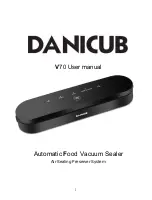
21
EN
Cleaning is the only maintenance action that
is required normally.
Warning! Cleaning must be done with the
crockery warmer disconnected from the
electrical power supply. Remove the plug
from the power socket or disconnect the
crockery warmer power supply circuit.
Do not use aggressive or abrasive cleaning
products, abrasive sponges or pointed
objects since stains or abrasion marks
may appear.
Do not use high pressure or steam jet
cleaning appliances.
Appliance front and control panel
The crockery warmer can be cleaned using
just a damp cloth. If it is very dirty, add a few
drops of washing-up liquid to the washing
water.
Wipe the surfaces dry using a dry cloth.
For stainless steel fronted crockery
warmers,
special products for treatment of
stainless steel surfaces can be used. These
products prevent the surfaces becoming dirty
again for some time. Apply a thin layer of such
a product on the surface using a soft cloth.
On aluminium fronted crockery warmers
use a gentle glass cleaning product and a soft
cloth that does not release fluff. Wipe
horizontally without pressing on the surface
since aluminium is sensitive to scratches and
cuts.
Interior of the crockery warmer
Clean the inside of the crockery warmer
regularly using a damp cloth. If it is very dirty
add a few drops of washing-up liquid to the
washing water.
Wipe the surfaces dry using a dry cloth.
Avoid water entering through the air
circulation opening.
Only use the crockery warmer again when it
is completely dry.
Mat with non-slip surface
The non-slip surface mat can be removed to
facilitate cleaning of the drawer.
The mat can be cleaned by hand using hot
water with a few drops of washing-up liquid.
Dry thoroughly.
The non-slip mat should only be replaced
when it is completely dry.
WARNING! Any type of repair must only be
done by a specialised technician. Any
repair done by a person not authorised by
the manufacturer is dangerous.
Before contacting Technical Assistance,
check on the following:
The
Check whether:
- The appliance has been switched on.
- The appropriate temperature has been
selected.
- The air circulation orifices are covered by
the crockery.
- The crockery was left to heat up for
sufficient time.
Heating time depends on several factors,
such as, for example:
- Crockery material type and thickness.
- Quantity of crockery.
- How the crockery is arranged.
The crockery
Check
whether:
- You can hear the noise of a fan.
If the fan is operating then the heating
element is broken; if the fan is not
operating then the fan is broken.
















































